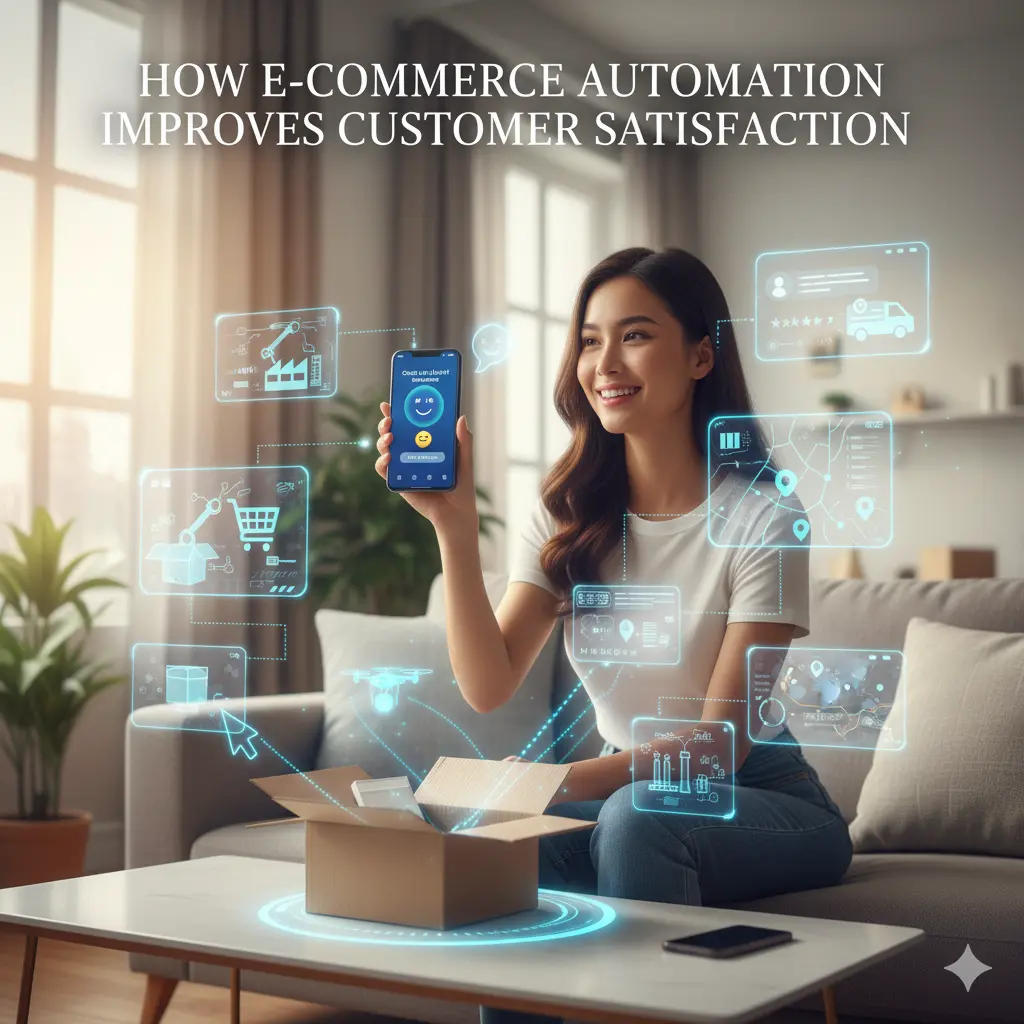In the fast-paced world of online shopping, customer satisfaction is a key differentiator for e-commerce businesses. Shoppers expect fast delivery, personalized experiences, accurate information, and seamless transactions. Meeting these expectations manually can be challenging, especially as order volumes grow. This is where e-commerce automation comes into play. Automation streamlines operations, reduces errors, and enhances the overall customer experience. By leveraging intelligent systems across inventory management, marketing, order fulfillment, and customer support, businesses can improve satisfaction, build loyalty, and drive long-term growth.
What is E-Commerce Automation?
E-commerce automation refers to the use of technology to perform repetitive, time-consuming tasks without human intervention. Automation can involve artificial intelligence (AI), machine learning, robotics, and software platforms that optimize workflows across the entire e-commerce ecosystem. From sending personalized emails to managing warehouse inventory and shipping orders, automation ensures efficiency and accuracy while allowing teams to focus on strategic initiatives.
Key Areas of E-Commerce Automation
- Inventory Management: Automated stock monitoring and replenishment prevent out-of-stock issues.
- Order Processing and Fulfillment: Streamlines order verification, packing, and shipping.
- Customer Support: AI chatbots handle queries instantly, providing 24/7 assistance.
- Marketing and Personalization: Automated campaigns target customers with tailored promotions.
- Analytics and Reporting: Real-time insights guide business decisions and improve customer experiences.
Faster and More Accurate Order Fulfillment
One of the most critical factors in customer satisfaction is timely and accurate delivery. E-commerce automation optimizes the fulfillment process, ensuring that orders are processed, packed, and shipped efficiently.
Automated Order Verification
Automation ensures that every order is checked for accuracy, including payment verification, shipping details, and product availability. This reduces errors, prevents delays, and minimizes the likelihood of returns. Customers receive exactly what they ordered, enhancing trust and satisfaction.
Robotic Warehousing and Smart Picking
Automated warehouses use robotics and conveyor systems to locate, pick, and package items quickly. This speeds up the fulfillment process, reduces human error, and allows businesses to scale operations during peak seasons without compromising service quality.
Predictive Inventory Management
AI-powered systems analyze sales patterns and forecast demand to maintain optimal stock levels. This reduces the risk of out-of-stock situations or overstocking, ensuring that customers can always find the products they want. Reliable inventory management directly improves the shopping experience.
Personalized Shopping Experiences
Modern customers expect personalized experiences that reflect their interests and preferences. E-commerce automation allows businesses to deliver tailored recommendations, content, and promotions at scale.
AI-Driven Product Recommendations
By analyzing browsing history, purchase behavior, and preferences, AI algorithms suggest products that match a customer’s interests. Personalized recommendations increase the likelihood of purchase and make the shopping experience more relevant and enjoyable.
Automated Marketing Campaigns
Automation enables targeted email campaigns, push notifications, and social media ads that respond to customer actions. For example, abandoned cart reminders, personalized discounts, or product updates can be sent automatically, prompting engagement and boosting conversion rates.
Dynamic Website Personalization
Automated tools can adjust website content, product listings, and banners based on user behavior in real time. Visitors see relevant products first, making navigation easier and increasing the chances of completing a purchase.
Improved Customer Support
Customer service is a critical touchpoint that significantly affects satisfaction. Automation ensures fast, consistent, and round-the-clock support.
AI-Powered Chatbots
Chatbots handle common inquiries such as order tracking, returns, product information, and FAQs instantly. They provide instant responses 24/7, reducing wait times and frustration for customers.
Automated Ticketing Systems
When complex issues arise, automation can categorize, prioritize, and assign support tickets to the right team members. This ensures that problems are resolved quickly and efficiently, keeping customers happy.
Proactive Issue Resolution
AI tools can detect potential issues, such as delayed shipments or payment failures, and automatically notify customers with solutions. Proactive communication prevents dissatisfaction and builds trust.
Faster Shipping and Delivery
Delivery speed is a major factor in customer satisfaction. Automation helps e-commerce businesses optimize logistics for faster and more reliable shipping.
Route Optimization
AI-driven systems analyze traffic, weather, and delivery schedules to determine the fastest and most efficient routes. This reduces shipping times and ensures that products reach customers on schedule.
Real-Time Tracking
Automated tracking systems provide customers with live updates on their order status. Transparency builds confidence and reduces anxiety about delayed deliveries.
Flexible Delivery Options
Automation allows businesses to offer flexible options such as same-day delivery, scheduled delivery, or smart locker pick-ups. Customers appreciate the convenience and control over how and when they receive their orders.
Enhanced Returns and Refunds
Returns are an inevitable part of e-commerce. Automation simplifies the returns process, reducing friction and improving customer satisfaction.
Automated Returns Processing
AI systems guide customers through the return process, generate labels automatically, and update inventory in real time. Quick and hassle-free returns improve the overall shopping experience.
Refund Automation
Automated systems process refunds faster, minimizing the wait time for customers and reinforcing trust in the brand. Customers are more likely to return to a store that handles returns efficiently.
Data-Driven Insights for Continuous Improvement
Automation provides access to valuable customer data that helps e-commerce businesses continually enhance the shopping experience.
Customer Behavior Analysis
AI tools track customer interactions, preferences, and purchase patterns to identify trends. Insights from this data guide product offerings, marketing campaigns, and website optimization.
Performance Monitoring
Automated analytics dashboards track KPIs such as delivery times, conversion rates, and customer feedback. Businesses can quickly identify bottlenecks and make improvements that directly impact satisfaction.
Predictive Customer Service
By analyzing historical data, AI predicts potential issues before they occur, allowing businesses to proactively address concerns and prevent negative experiences.
Conclusion
E-commerce automation is no longer a luxury; it is essential for delivering a superior customer experience. By streamlining order fulfillment, personalizing the shopping journey, enhancing customer support, optimizing delivery, and simplifying returns, automation directly contributes to higher customer satisfaction. Businesses that embrace automation can meet growing customer expectations, reduce errors, and build loyalty that drives long-term success.


